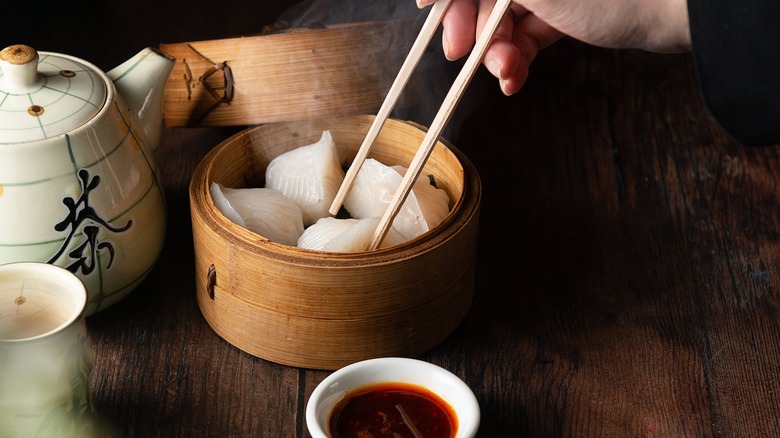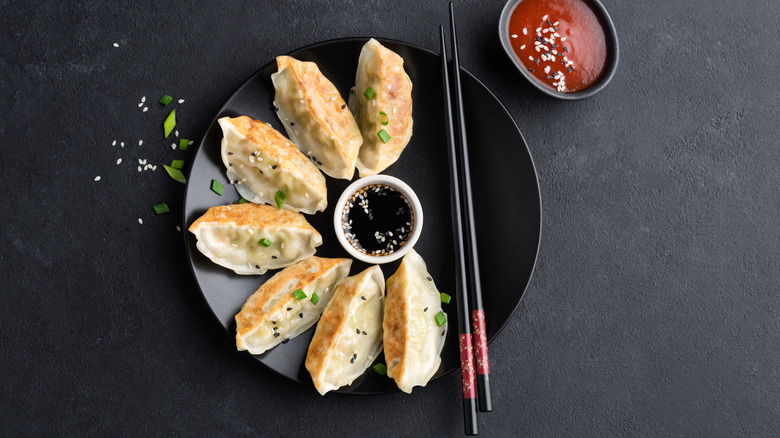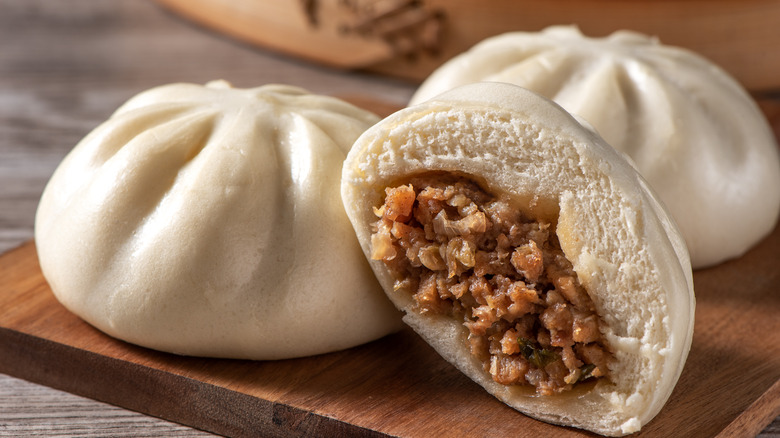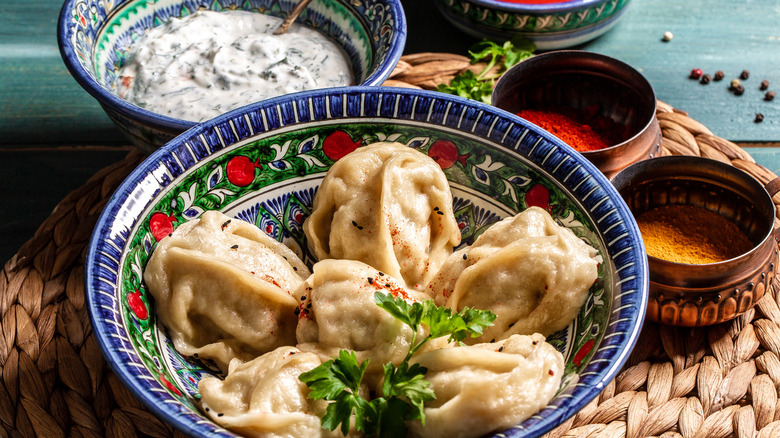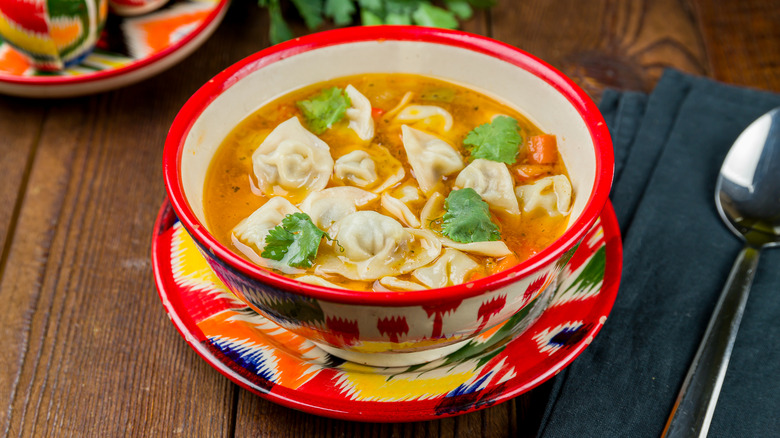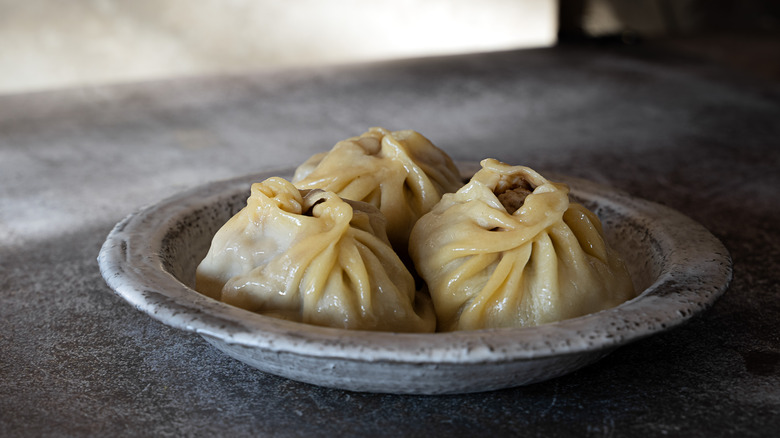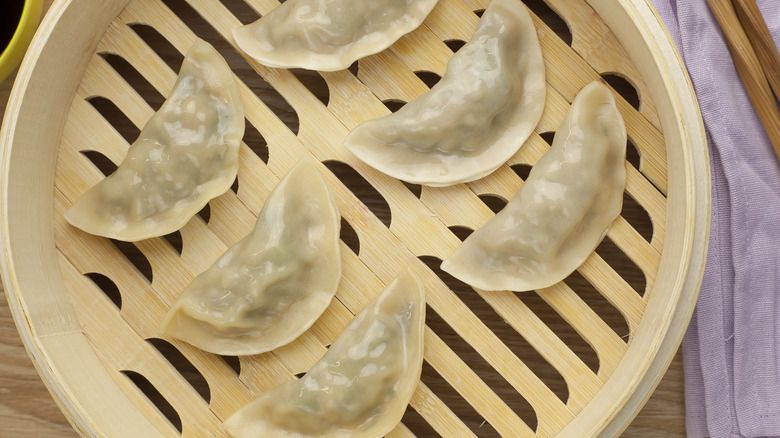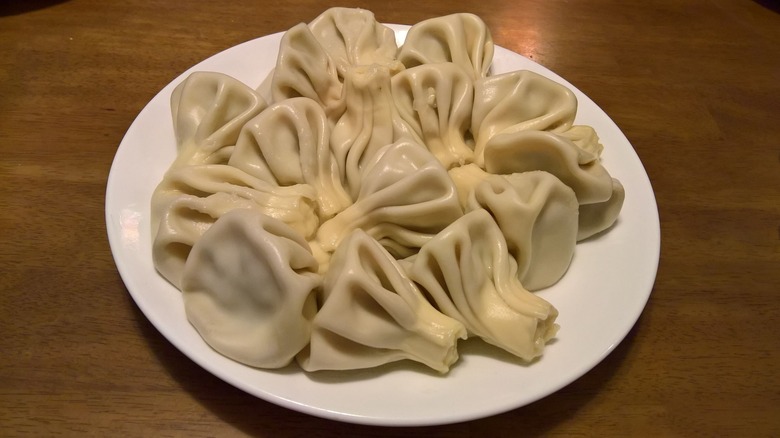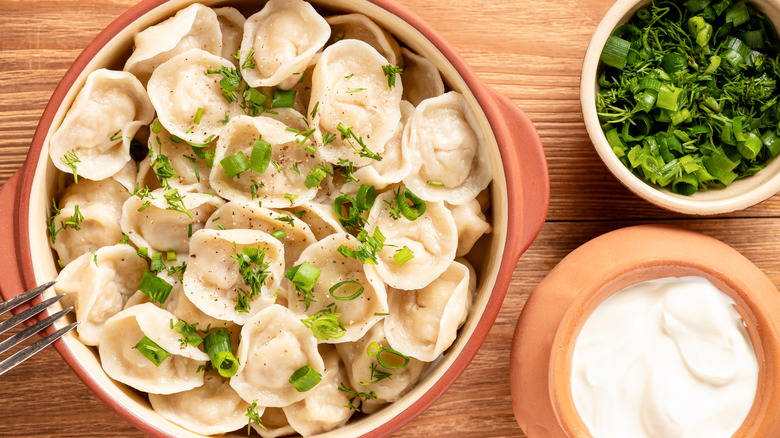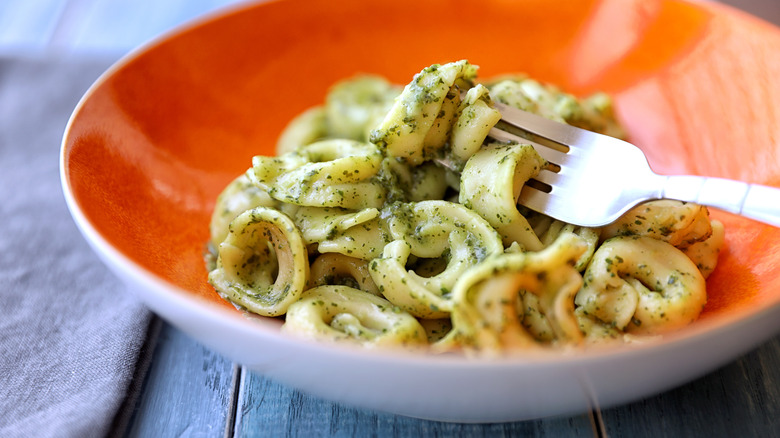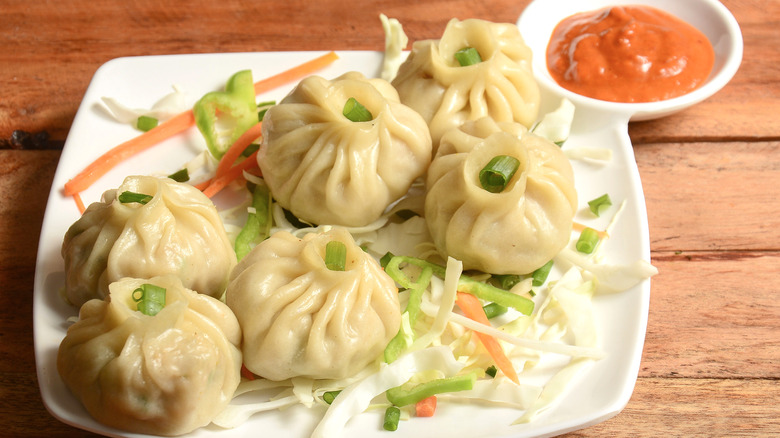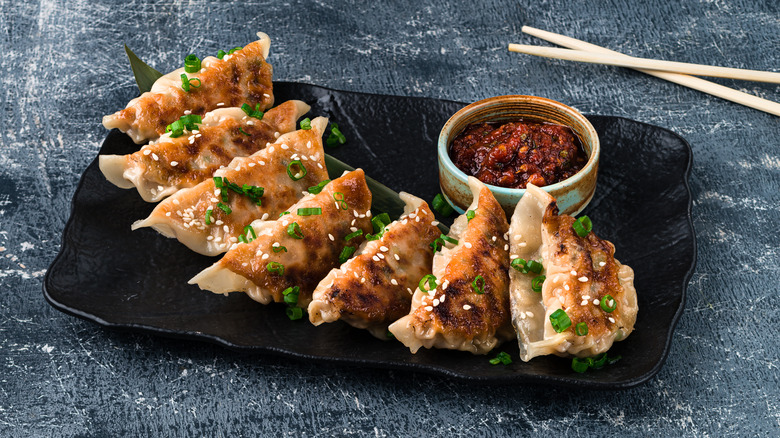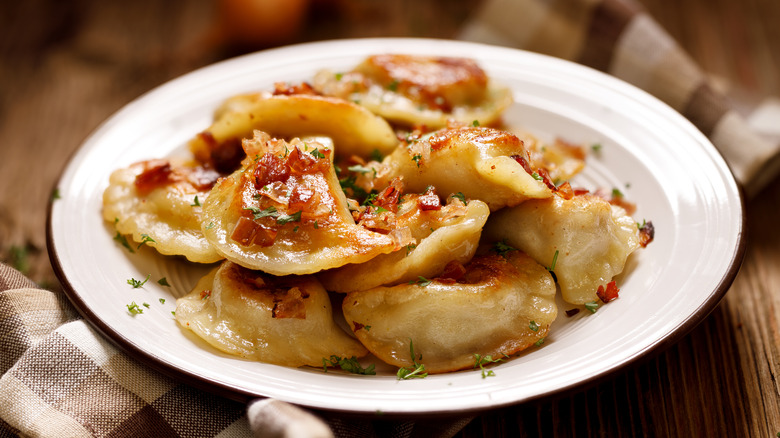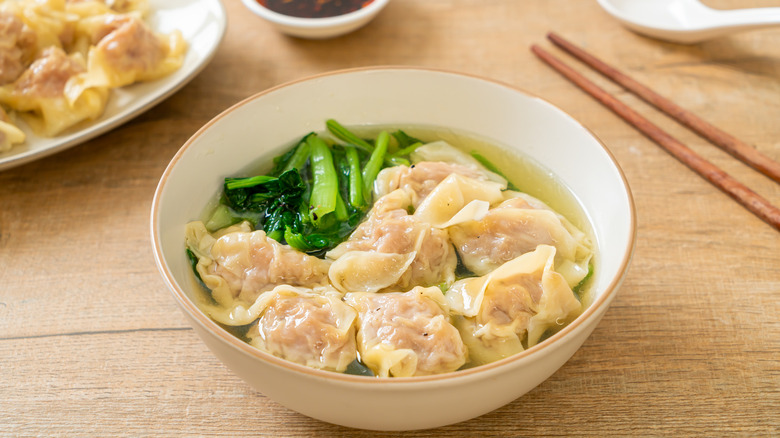The Ultimate Guide To Dumplings
In English, we only have one word for dumplings, those delicious little bundles of meat and vegetables wrapped in pastry. This can make it easy for us not to realize that filled dumplings are actually a sprawling family of foods that spans all across Eurasia. And as you might expect from such a widespread type of food, their origins date back thousands of years.
One of the best-known cuisines that include dumplings is Chinese dim sum, which has its origins along the Silk Road. Per Folklife Festival, the Silk Road was a trade route of the ancient world, spanning from China to the Mediterranean. As well as silk, the merchants who traveled this road also carried things like spices and foods like noodles and dumplings. Britannica mentions that perhaps as long as 2,500 years ago, teahouses along the Silk Road would serve refreshments to travelers. As well as tea, they would serve dim sum as snacks. Culture Trip notes that the name dim sum translates as "to touch the heart," showing its origins as a bite-sized food intended to hit the spot.
As The Washington Post explains, the exact origin of dumplings is a matter of some debate, but wherever they came from, they show a long-standing shared culture across Eurasia. At the same time, dumplings are often a proud part of a country's heritage. So here are some of the most prominent types of dumplings enjoyed in the world today, and the cultures that make and love them.
Jiaozi
One of the oldest known types of filled dumplings also comes from China. Often known as potstickers, jiaozi , and their variations are perhaps the most common type of dumpling in the world, making for anything from a tasty snack to a wholesome meal. According to legend, they were first made 1,800 years ago, and they were originally intended to be medicinal!
As China Daily explains, jiaozi were created by a man named Zhang Zongjing from the Eastern Han Dynasty, known in Chinese history as the Medicine Saint. One winter, he noticed people in his home village with frostbitten ears and created a food packed full of medicinal herbs, folded into the shape of an ear. So jiaozi were born, and they're still a popular winter food in Northern China today, particularly during the Spring Festival.
While Zhang's original recipe was said to be made with spicy mutton, these delicious potstickers are flexible enough that they're now made with a variety of fillings. Jiaozi can be prepared by boiling, steaming, pan-frying, or even baking, and make a wholesome meal at any time of day.
Mantou and bao
The other well-known type of Chinese dumpling is baozi, more commonly called bao. These are bread dumplings, normally steamed or pan-fried, and stuffed with either sweet or savory fillings. Char siu is one of the most popular and well-known, and char siu bao are easy to find in cities like Hong Kong.
As Great British Chefs explains, bao were likely invented around 2,400 years ago and a rather gruesome legend attributes them to a Chinese military strategist named Zhuge Liang. Liang needed to get his army across a river, but it was impossible to wade through. A local barbarian advised that he needed to sacrifice some of his men and throw their heads into the river to appease the gods. Unwilling to perform such an act, he created buns stuffed with meat and offered these to the gods instead. The dish was appreciated by the gods and the soldiers alike, and it became known as mantou, which roughly translates as "barbarian's head." It's a nice tale, but it may well be just a legend.
In later times, mantou began to refer to steamed, unfilled rolls, while the filled dumplings became known as baozi. According to Eileen Guo, mantou are popularly steamed, but can also be deep-fried or even dunked in condensed milk. Perhaps the biggest contribution of mantou though, is that it lent its name to a variety of other dumplings across Asia, from Korea all the way to Turkey.
Manti
Manti is one of the most widely used names for dumplings, and dumplings called manti are eaten all across Central Asia, from Armenia to Uzbekistan. As for where manti originated, The Atlantic mentions that it's a matter of much debate, complicated by the fact that there is no single type of manti. Their style varies wildly from place to place, from tiny dumplings to large, hearty ones, some with very fine wrapping, and some made with a much thicker pastry.
Travel Food Atlas notes that manti are a popular food in Kazakhstan where they're often eaten as street food with a dash of hot pepper powder or a rich garlic sauce. A popular Kazakh filling for manti is horse meat, though they can also be stuffed with mutton or beef, as well as pumpkin and other seasonings. Locals stress the importance of using fatty meat for a good texture and a wholesome flavor.
Daily Sabbah explains how Turkish manti are small and typically stuffed with ground lamb and onion. Turkish manti are a luxurious dish, with much smaller dumplings topped with a creamy, garlic yogurt sauce and a little melted butter. Another rich sauce made from tomato and red pepper is also a popular addition. While they may change wildly from place to place, all manti certainly have one thing in common — they're an excellent comfort food in cold weather!
Chuchvara
Manti aren't the only type of dumpling eaten across Central Asia. According to Folkways, chuchvara were introduced around Asia by the Persian Empire. In pre-Islamic Persia, they were known as joshpara, translating loosely as "boiled pieces." In the modern world, they're strongly associated with Uzbek culture, though they're also popular in a variety of cultures, from the Uyghur people of Northern China to the Arab world.
The Arabic version of chuchvara is, of course, halal. These dumplings are the main ingredient of a creamy dish called shish barak. Arab America explains that this traditional dish dates back to at least the 14th century, though its exact origins are seemingly lost to time. Today, it's a popular meal in Palestine, Syria, Jordan, and Lebanon. Stuffed with meat and fresh herbs, the dumplings are served in a yogurt sauce flavored with garlic and mint, and some people prefer to make their shish barak with goat's milk, which reportedly makes for a richer, creamier flavor.
Buuz
Starting in the 13th century, the Mongols swept across Asia conquering everything in their path (via Britannica). Under the command of Genghis Khan, one of the first places they claimed was China, claiming both land and food, and it's quite likely they went on to spread dumplings westwards across Asia. According to Around the World in 80 Cuisines, the name "buuz" derives from the Mandarin word "baozi."
Dumplings were extremely popular with the Mongols. As the South China Morning Post explains, it's likely because warriors considered them a convenient way to carry food on their campaigns. With buuz, they could carry small bundles of meat for sustenance, even on the battlefield. The food became so popular that, as "The Ethnomusicologists' Cookbook" notes, they're still a celebrated Mongolian food in the modern day and an essential part of a Mongolian Lunar New Year celebration.
Per Eurasianet, buuz are best stuffed with meat bought from a local market. Mixed with cabbage and flavored with onion, garlic, and herbs, buuz are usually steamed. In the highlands of Mongolia, they're usually cooked on a stove in the center of a kitchen yurt and eaten by hand.
Mandu
The Korean version of dumplings is known as mandu, and their fillings have a distinctly Korean twist. In addition to meat and vegetable fillings, mandu can also be stuffed with kimchi as a spicy treat. As versatile as jiaozi, they can be steamed, fried, boiled, or even used to make soup. In Korean kitchens, it's quite common to make a big batch of mandu and then freeze them to eat later, as anything from a light snack to a full meal.
Mandu were reportedly introduced to Korea by the Mongols. According to Travel Food Atlas, this happened sometime during the 14th century during the Goryeo Dynasty. Originally, mandu were a food reserved for nobility, reserved for the royal court, and eaten only on the most special occasions. Today though, they're an essential part of Korean home cooking. Even the dumpling skins are usually made from scratch. A true folk food, there are a wealth of old family recipes for mandu, with their own distinctive twists and ingredients.
Khinkali
Hailing from Georgia, khinkali are a hulking, distinctive, and lavishly-seasoned kind of dumpling. They're a common sight on Georgian tables at lunchtime, where the traditional way to eat them is to hold them by the tip while eating and discard the tip afterward like cherry stems. What's more, as BBC Travel explains, they're tightly bound into the history and culture of Georgia. The origins of khinkali are anything but clear. At least three regions claim to have invented them, all in mountainous parts of the country. Accordingly, in Georgian culture, these big dumplings are seen as mountain food to give people energy after they come indoors from the cold.
Much larger than typical Chinese dumplings, khinkali are a beloved part of Georgian cuisine, and the people are fiercely protective of their dumplings. While their true history may be lost to time, it's likely they were inspired by the Mongols. According to the South China Morning Post, this likely happened sometime around the 13th century when the country also hosted important landmarks on the Silk Road. Even the origin of the name is uncertain, but there's a popular story that the word khinkali originally came from the phrase "Khan's head."
Pelmeni
It's easy to forget that, going purely by area, most of Asia is Russia. As you might expect then, Russia too has its own types of dumplings. One popular Russian dumpling is pelmeni, which originated in Siberia. According to SBS, it was first made by the Komi people who live in the Ural Mountains, becoming popular and spreading westwards towards Europe. Pelmeni were first cooked in the 14th century, although manti were already a popular food in Russia at the time. The story goes, hunters in Siberia carried pelmeni with them on their expeditions. In the icy Siberian weather, the dumplings could be kept frozen, keeping fresh for a long time and making them a convenient way to have a flavorsome and easy-to-cook meal at hand.
Russian chefs stress that because pelmeni are so simple to prepare, it's important to use high-quality ingredients when cooking them. They're stuffed with a mix of beef, lamb, and pork, and seasoned with garlic, onion, and black pepper. Also, very importantly, it's best to use fatty meat when making pelmeni, to make certain the finished dumplings don't turn out too dry. They can be fried or made into soup, but the usual way to enjoy a serving of pelmeni is to boil them and serve them with sour cream and a sharp condiment like vinegar or mustard.
Ravioli and Tortellini
At the westernmost end of the Silk Road is Italy, particularly the city of Venice. Per UNESCO, Venetian traders were among the many merchants who once traveled the Silk Road. Italy is also home to some of Europe's best-known dumplings – ravioli. According to Cucinaventi, like many dumplings, ravioli date back to the 14th century, when the classic recipe involved fresh cheese and fragrant herbs. The characteristic square dumplings were traditionally eaten on Fridays, as well as during the Christian season of Lent. The origins of ravioli, however, seemingly come from the Arab world. According to the "Encyclopedia of Pasta," it originated under the name "sambusaj" and was first written about in an 11th-century Arabic book of gastronomy. These dumplings would later be brought to Sicily by Muslim travelers, and the dish would evolve to become known as raviolo.
Another dumpling that may have originated around the same time is tortellini, though its name has changed over time. It was seemingly known in the 1600s as tortello, and the "Encyclopedia of Pasta" also notes a Venetian recipe in 1570, known as tortelleti. While ravioli may have been introduced from the South, it's possible that tortellini (and tortelloni) were at least partially inspired by dumplings from the Silk Road.
Momo
Popular in South Asia, momo are another type of dumpling with its origins in the 14th century. As with much South Asian cuisine, momo fillings are flavored with a variety of aromatic and wholesome spices like cumin, coriander, garlic, and chili. They're traditionally made with buffalo meat, though they can now be found with fillings based around chicken, vegetables, or cheese. As well as their fragrant fillings, they're usually served with a selection of spicy, tangy sauces.
As with many dumplings, their origins are contested, and as Times of India explains, both Nepal and Tibet claim to be the inventors of them. Wherever they originally came from, they're an essential part of Nepali cuisine. As Slow Food notes, "Momo is to Nepal what pizza is to Italy." They're a ubiquitous part of Nepali cuisine and culture, having been enjoyed there for centuries. However, it was Tibetans who brought momo to South Asia. During the 1960s, there was an influx of Tibetan immigrants into India, following the Chinese annexation of Tibet in the 1950s (via UMass).
India was already home to a type of sweet dumpling called modak, so it didn't take much for momo to become popular on Indian menus too. Across the country, momo are now made with a distinctly Indian twist, with fillings like paneer, spicy chicken, or seafood. They're versatile enough that they're served by high-class restaurants and street food stalls alike!
Gyoza and manju
Anyone familiar with Japanese cuisine will likely be familiar with gyoza, usually made with fillings of meat and vegetables, and often with garlic or ginger added for flavor. Surprisingly filling and immensely hearty, Japanese gyoza are usually pan-fried or grilled and eaten dipped in soy sauce and chili oil. Popular all across Japan, and with a wealth of local variations, gyoza are a local specialty of the town of Utsunomiya. Proclaiming itself Japan's gyoza capital, it even hosts a regular gyoza festival (via Japan Travel). The history of gyoza in Japan, however, is a bit shorter than that of some other dumplings. According to Food In Japan, the oldest record of Japanese gyoza were dumplings made with duck meat, in 1689 during Japan's Edo period.
Japan's other dumpling is sweet and has older origins. Manju, as Bokksu explains, were first brought to Japan from China in the 14th century. Round and with a cake-like texture, elaborately packaged boxes of manju are often given as gifts in Japan and can be filled with a number of sweet fillings, with anko (sweet azuki bean paste) being a popular one. Occasionally, a type of manju can be deep-fried and caramelized, making karinto-manju. Blissfully crunchy and indulgent, these snacks are quite a treat for anyone with a sweet tooth.
Pierogi
Pierogi are a beloved and celebrated part of Polish culture. These half-moon-shaped dumplings are enjoyed widely throughout Poland, as well as by Polish diaspora in other parts of the world, like the U.S. Culture.pl explains that there are all manner of recipes for pierogi, and the fillings may include various kinds of meat, buckwheat, lentils, fish, or cheese. The most common pierogi filling though is cheese and potato. They're classically enjoyed with a little braised sauerkraut, forest mushrooms, fried onions, or pieces of bacon. But pierogi can also be eaten for dessert, stuffed with fruit or with a sweet poppyseed filling, and served with custard or chocolate ganache.
Pierogi reportedly date back to the 13th century when dumplings were introduced from East Asia. Popular folklore attributes them to Hyacinth of Poland, a monk who has since become heralded as the Patron Saint of Pierogi. The true origins of Poland's favorite dumpling, though, are uncertain. BBC Travel notes that records go back to at least 1682 — a recipe for them is included in the oldest known Polish cookbook, "Compendium Ferculorum, albo Zebranie potraw." A comfort food for people at all levels of society, pierogi have always been made with whatever fillings were available, with the upper classes making theirs with expensive imported ingredients and working-class people enjoying pierogi made with local produce.
Wontons
Wontons are now widely known as a simple restaurant meal, famously served in a thin soup, but wonton soup long predates the plastic takeout containers in which many Americans now receive it. It has a long history as a Chinese dish and, as Tourism Richmond explains, was very popular during the Qing Dynasty of the 17th century.
Wontons are made with thinner skins than other dumplings, turning slightly translucent when boiled into soup. Their filling is usually pork, prawns, ginger, and shallots, though both fillings and soup may vary. In some parts of China, wontons are served alongside noodles in soup, while in others the soup is bright red and flavored with chili oil. It's also common for wontons to be fried until crispy and enjoyed with dipping sauces as a starter.
The true origin of wontons, like many of the most traditional Chinese dishes, is old enough to be a matter of legend rather than history. The legend in question, as Beijing Tourism explains, dates back to the Han Dynasty, over 2,000 years ago. At the time, China was besieged by the invading Huns (who many may know from Disney's version of "Mulan"). Particularly despised were the Hun leaders, named Hun and Dun. As a kind of coping mechanism, the people of Northern China created dumplings which they called "hun dun," so they could symbolically eat their troubles away. So the story goes, they've been enjoyed in China ever since — and now they're enjoyed around the world too!
